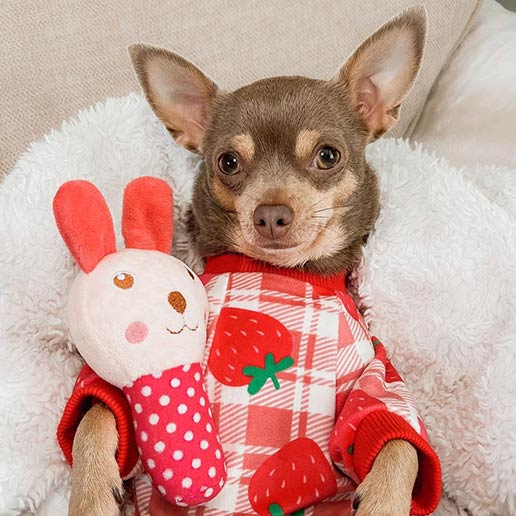First Night with Puppy: 5 Training Methods That Work
That first night with a new puppy can be quite like having a newborn baby—exciting yet very nerve-wracking. Your furry friend has just left everything they know behind: mom, brothers and sisters, and surroundings. While you may be beyond excited to bring them home, they could be scared and unsure. It is totally normal and understandable to worry about how that first night will go. Fortunately, with the proper set up of sleep space, potty breaks, and handling of those midnight whimperings, you can let your puppy know he's safe and secure in his new home.

1. Create a Den-Like Sleep Space for Your Puppy
Your new puppy needs a safe, comfortable space to call their own. A proper sleeping area helps them feel protected and secure during their first nights away from their family.
Start off with a crate or enclosed bed that just fits your little one; this is so that they can stand, turn around, and lie down. Ask your breeder for a blanket or soft toy from their previous home, as these smells can do wonders for comfort. A warm water bottle wrapped in a cozy dog sweater or blanket, along with a heartbeat toy, can recreate the warmth they felt with their siblings.
Place their sleeping spot beside your bed the first night or two to give them the security of knowing that you're nearby. When comfortable, work them by crate location and destination desired by you. During colder nights, a small fleece dog jacket or dog shirt made specifically for puppies can provide extra warmth and security.

Common mistakes to avoid:
● Keep toys in the crate minimal—one or two comfort items are enough
● Never place their den in noisy hallways or isolated areas
● Don't use an oversized crate—smaller, cozier spaces feel more secure
● Skip regular clothes or blankets that could be too heavy or restrictive
2. Set Up a Calming Bedtime Routine
A peaceful evening routine signals to your puppy that it's time to wind down, much like how soft music and dimmed lights help babies prepare for sleep.
Start to wind them down about an hour before bedtime. Activities should be light and soothing, such as a light brushing session with a soft puppy brush or some quiet time with a plush toy. This is a great time to put them in their sleepy time outfit if you use one. Many pet parents find a sleeping vest helps their puppies feel snuggly and secure.
Timing is everything: Take your dog outside for one last potty break, about 30 minutes before bedtime. Once back inside, simulate sleep time by drawing the blackout curtains and turning on the white noise-just a small fan or sound machine will do the trick to muffle any sudden noises that could wake your puppy up.

Simple tips for success:
● Use the same phrase every night, like "bedtime" or "night-night"
● Keep the routine short and consistent
● Make sure any nightwear is comfortable and not too tight
● Avoid exciting games or treats right before bed
● Keep the room temperature comfortable—not too hot or cold
3. Handle Nighttime Potty Breaks
Young puppies have tiny bladders and need frequent bathroom breaks, even during the night. The key to successful nighttime potty training lies in consistency and maintaining a business-like approach.
During the first few weeks, you'll need to wake up every few hours to take your puppy out. The frequency depends on your puppy's age:
|
Puppy Age |
Recommended Potty Break Intervals |
|
8-10 weeks |
Every 2-3 hours |
|
3-4 months |
Every 3-4 hours |
|
4-6 months |
Every 4-5 hours |
|
6+ months |
Every 5-6 hours |
When taking your puppy out at night, keep these essential rules in mind: Use a leash to prevent wandering and playing, keep the lights dim, and avoid talking or making eye contact. Your pup needs to learn that nighttime potty breaks are strictly business—no playing, no treats, and no excitement.
If accidents happen (and they likely will), stay calm and clean the spot thoroughly with an enzymatic cleaner. These special cleaners break down the proteins in urine and feces, removing both stains and odors that might encourage your dog to mark the same spot again. Regular household cleaners won't eliminate these scent markers effectively.

4. Manage Those Midnight Whimpers
Every puppy parent faces the challenge of nighttime crying. While it's natural to want to comfort your distressed pup immediately, having a clear strategy helps both of you get through those first few nights more smoothly.
Do:
● Wait for a brief moment of quiet before responding to whining
● Use a soft, calming voice when you need to check on them
● Keep the room at a comfortable temperature
● Consider using a light sheet to cover three sides of the crate
● Stay consistent with your response strategy
Don't:
● Rush to open the crate when your puppy is actively crying
● Offer treats or toys during nighttime wake-ups
● Make eye contact or engage in play during night checks
● Scold or show frustration when they whine
● Give up on your routine after just one or two difficult nights 
Most puppies adjust to their new home within a few days to a week. Your puppy isn't trying to manipulate you—they're just learning to feel secure in their new environment. Many pet parents report that their dog's crying reduced significantly by the second or third night, especially after making small adjustments like adding a crate cover or maintaining a consistent response pattern.
5. Phase Out Co-Sleeping Gradually
While keeping your puppy's crate near your bed provides security during their first night home, gradually moving their sleeping space to a permanent location helps develop independence. This transition should be planned carefully to maintain your puppy's confidence and sleep quality.
Recommended 3-Week Transition Schedule:
|
Week |
Location |
Distance |
Support Items |
|
1 |
Bedroom |
Next to bed |
- Comfort toy with a heartbeat - Familiar blanket - White noise machine |
|
2 |
Hallway/Doorway |
5-10 feet from bedroom |
- Frozen Kong before bedtime - Lick mat for settling - Crate cover |
|
3 |
Final Location |
Target room |
- Long-lasting chew toy - Calming treats - Familiar bedding |

Each time you move the crate, make it extra appealing with special bedtime rewards. Consider using a high-quality modular crate system that can be adjusted as your puppy grows. These expandable crates offer consistent familiarity while adapting to your puppy's increasing size, making them a worthwhile investment for the transition period and beyond.
If your puppy shows signs of distress during any phase, slow down the transition. It's better to take an extra week than to rush and create anxiety about their sleeping space. Some puppies may need smaller incremental moves between major location changes.
Common Concerns Every New Puppy Parent Has
Q1: How long will my puppy cry on the first night?
A: The average is 3 to 7 nights for most puppies to stop crying at night. For some puppies, though, depending on age, personality, and earlier experiences, it could take up to 2 weeks.
Q2: Should I use pee pads in the crate?
A: No. Pee pads in the crate will confuse house training efforts. Use washable, waterproof bedding instead, and keep regular potty breaks throughout the night.

Q3: Is the first night with a puppy the hardest?
A: Yes. The first night is usually the most difficult as your puppy is in a new environment away from his littermates. Every subsequent night usually gets easier and easier.
Q4: Where should a new puppy sleep the first night?
A: In a crate beside your bed. This offers the perfect comfort and security but also allows one to establish limits and sleep behavior from day one.
Q5: Should I leave my puppy alone the first night?
A: No, on the first night, keep your puppy's crate close to you but in their sleeping space. This will make them feel safe and build up a bit of independence.

Q6: Should I ignore my new puppy crying at night?
A: Partially. Respond only when there are brief pauses in crying to check for potty needs. Avoid playing or giving attention during these checks to prevent reinforcing crying behavior.
Q7: Should I cuddle my puppy on the first night?
A: Very minimal cuddling only. Brief, pre-sleep cuddles are fine, but avoid very long bedtime cuddling to nip sleep dependency in the bud and also to set a boundary.














